Kinetics of Interactions of Matter, Antimatter and Radiation Consistent with Antisymmetric (CPT-Invariant) Thermodynamics
Abstract
:1. Introduction
2. Chain of Unitary and Decoherence Events
3. Kinetics and Thermodynamics of Indirect Interactions of Matter and Antimatter
3.1. Symmetric Kinetics
3.2. Antisymmetric Kinetics
3.3. Properties of Antisymmetric Kinetics
- Early universe: . Equilibrium under conditions of having the same amounts of matter and antimatter, which is specified by and , is neutral and can be achieved at different temperatures but is subject to the additional condition , which must be satisfied in compliance with the solution that has infinite temperature .
- Travelling to antiworld: . A matter traveller of a small mass travels to an antiworld populated by large amounts of antimatter (or the traveller is a fictional Time Lord and somehow manages to turn his world line back in our world time). This case has a stable thermodynamic equilibrium. Assuming that the intrinsic temperature of antiworld is positive this equilibrium can be achieved only at negative temperatures of the traveller. Practically this means that the traveller would be burned.
- Experiment with antimatter: . In this case equilibrium between matter and antimatter is unstable and practically impossible. Depending on initial conditions, the antimatter object would fall into the intrinsic ground state (apparent roof state) or, possibly but much less likely, into the intrinsic roof state (apparent ground state).
3.4. H-Theorems for Symmetric and Antisymmetric Kinetics
4. Interactions of Radiation and Matter
4.1. Radiation with Prevailing Decoherence
4.2. Radiation with Prevailing Recoherence
4.3. Decoherence-Neutral Radiation
5. Interactions of Radiation and Antimatter
6. Discussion and Conclusions
Acknowledgments
Conflicts of Interest
Appendix A. Quantum Typicality, Mixtures and Decoherence
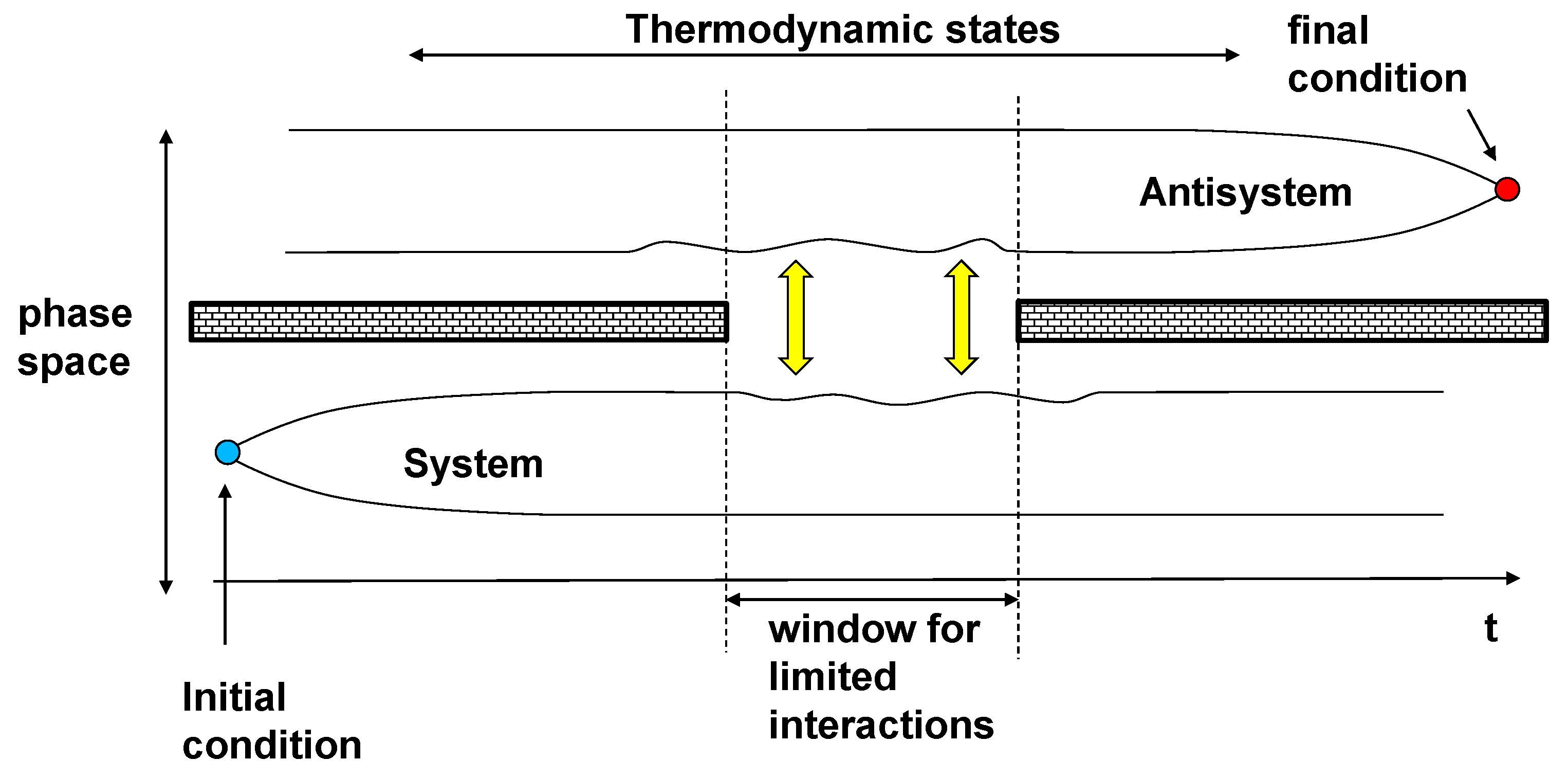
References
- Boltzmann, L. Lecures on Gas Thoery; University of California Press: Berkeley, CA, USA, 1964. [Google Scholar]
- Price, H. Time’s Arrow and Archimedes’ Point: New Directions for the Physics of Time; Oxford University Press: Oxford, UK, 1996. [Google Scholar]
- Penrose, R. Road to Reality: A Complete Guide to the Laws of the Universe; A. Knopf: New York, NY, USA, 2005. [Google Scholar]
- Zeh, H.D. The Physical Basis of The Direction of Time, 5th ed.; Springer: New York, NY, USA, 2007. [Google Scholar]
- Abe, S. Maximum-power quantum-mechanical Carnot engine. Phys. Rev. E 2011, 83, 041117. [Google Scholar] [CrossRef] [PubMed]
- Gogolin, C.; Eisert, J. Equilibration, thermalisation, and the emergence of statistical mechanics in closed quantum systems. Rep. Prog. Phys. 2016, 79, 056001. [Google Scholar] [CrossRef] [PubMed]
- Klimenko, A.; Maas, U. One Antimatter-Two Possible Thermodynamics. Entropy 2014, 16, 1191–1210. [Google Scholar] [CrossRef]
- Klimenko, A.Y. Symmetric and antisymmetric forms of the Pauli master equation. Sci. Rep. 2016, 6, 29942. [Google Scholar] [CrossRef] [PubMed]
- Sakharov, A.D. Violation of CP invariance, C asymmetry, and baryon asymmetry of the universe. J. Exp. Theory Phys. 1967, 5, 24–27. [Google Scholar]
- Pauli, W. Uber das H-Theorem vom Anwachsen der Entropie vom Standpunkt der neuen Quantenmechanik. In Probleme der Modernen Physik. Arnold Sommerfeld zum 60 Geburtstage; Hirzel: Leipzig, Germany, 1928; pp. 30–45. (In German) [Google Scholar]
- Zurek, W.H. Decoherence and the Transition from Quantum to Classical—Revisited. Los Alamos Sci. 2002, 27, 86–109. [Google Scholar]
- Bassia, A.; Ghirardi, G. Dynamical reduction models. Phys. Rep. 2003, 379, 257–426. [Google Scholar] [CrossRef]
- Beretta, G. On the general equation of motion of quantum thermodynamics and the distinction between quantal and nonquantal uncertainties (MIT, 1981). arXiv, 2005; arXiv:quant-ph/0509116. [Google Scholar]
- Stamp, P.C.E. Environmental decoherence versus intrinsic decoherence. Philos. Trans. Ser. A Math. Phys. Eng. Sci. 2012, 370, 4429. [Google Scholar] [CrossRef] [PubMed]
- Zurek, W.H. Environment-induced superselection rules. Phys. Rev. Lett. 1982, 26, 1862–1888. [Google Scholar] [CrossRef]
- Joos, E.; Kiefer, C.; Zeh, H.D. Decoherence and the Appearance of a Classical World in Quantum Theory, 2nd ed.; Springer: Berlin/Heidelberg, Germany, 2003. [Google Scholar]
- Schlosshauer, M. Decoherence, the measurement problem, and interpretations of quantum mechanics. Rev. Mod. Phys. 2005, 76, 1267–1305. [Google Scholar] [CrossRef]
- Goldstein, S.; Lebowitz, J.L.; Tumulka, R.; Zanghi, N. Canonical typicality. Phys. Rev. Lett. 2006, 96, 050403. [Google Scholar] [CrossRef] [PubMed]
- Popescu, S.; Short, A.J.; Winter, A. Entanglement and the foundations of statistical mechanics. Nat. Phys. 2006, 2, 754–758. [Google Scholar] [CrossRef]
- Yukalov, V. Equilibration and thermalization in finite quantum systems. arXiv, 2012; arXiv:1201.2781. [Google Scholar]
- Braun-Munzinger, P.; Stachel, J. The quest for the quark-gluon plasma. Nature 2007, 448, 302–309. [Google Scholar] [CrossRef] [PubMed]
- Aharonov, Y.; Bergmann, P.; Lebowitz, J. Time Symmetry in the Quantum Process of Measurement. Phys. Rev. B 1964, 134, 1410. [Google Scholar] [CrossRef]
- Wharton, K.B. Time-Symmetric Quantum Mechanics. Found. Phys. 2007, 37, 159–168. [Google Scholar] [CrossRef]
- Aharonov, Y.; Vaidman, L. The Two-State Vector Formalism: An Updated Review. Lect. Notes Phys. 2008, 734, 399–447. [Google Scholar]
- Dyson, F.J. The radiation theories of Tomonaga, Schwinger, and Feynman. Phys. Rev. 1949, 75, 486–502. [Google Scholar] [CrossRef]
- Landau, L.D.; Lifshits, E.M. Course of Theoretical Physics Vol. 3: Qunatum Mechanics; Butterworth-Heinemann: Oxford, UK, 1980. [Google Scholar]
- Einstein, A. The Quantum Theory of Radiation. Phys. Z. 1917, 18, 121. [Google Scholar]
- Dirac, P.A.M. The Quantum Theory of the Emission and Absorption of Radiation. Proc. R. Soc. Lond. A Math. Phys. Eng. Sci. 1927, 114, 243–265. [Google Scholar] [CrossRef]
- Fermi, E. Quantum Theory of Radiation. Rev. Mod. Phys. 1932, 4, 87–132. [Google Scholar] [CrossRef]
- Berestetskii, V.; Lifshitz, E.; Pitaevskii, L. Course of Theoretical Physics Vol. 4: Quantum Electrodynamics; Butterworth-Heinemann: Oxford, UK, 1982. [Google Scholar]
- Andrews, D. A unified theory of radiative and radiationless molecular energy transfer. Chem. Phys. 1989, 135, 195–201. [Google Scholar] [CrossRef]
- Griffiths, D. Introduction to Quantum Mechanics, 2nd ed.; Prentice Hall: Upper Saddle River, NJ, USA, 2005. [Google Scholar]
- Salam, A. Molecular Quantum Electrodynamics: Long-Range Intermolecular Interactions; John Wiley and Sons: Hoboken, NJ, USA, 2010. [Google Scholar]
- Ramsey, N.F. Thermodynamics and Statistical Mechanics at Negative Absolute Temperatures. Phys. Rev. 1956, 103, 20–28. [Google Scholar] [CrossRef]
- Landau, L.D.; Lifshits, E.M. Course of Theoretical Physics Vol. 5: Statistical Physics; Butterworth-Heinemann: Oxford, UK, 1980. [Google Scholar]
- Klimenko, A.Y. Teaching the third law of thermodynamics. arXiv, 2012; arXiv:1208.4189. [Google Scholar]
- Klimenko, A. Note on invariant properties of a quantum system placed into thermodynamic environment. Phys. A Stat. Mech. Appl. 2014, 398, 65–75. [Google Scholar] [CrossRef]
- Haken, H. Light (v1: Waves, Photons, Atoms, v2: Laser Light Dynamics); North-Holland Pub.: Amsterdam, The Netherlands, 1981. [Google Scholar]
- Madsen, N. Cold antihydrogen: A new frontier in fundamental physics. Philos. Trans. R. Soc. A 2010, 368, 3671–3682. [Google Scholar] [CrossRef] [PubMed]
- Andronic, A.; Braun-Munzinger, P.; Stachele, J.; Stöckera, H. Production of light nuclei, hypernuclei and their antiparticles in relativistic nuclear collisions. Phys. Lett. B 2011, 697, 203–207. [Google Scholar] [CrossRef]
- Lloyd, S. Black Holes, Demons and Loss of Coherence. Ph.D. Thesis, The Rockefeller University, New York, NY, USA, 1988. [Google Scholar]
- Bocchieri, P.; Loinger, A. Quantum Recurrence Theorem. Phys. Rev. 1957, 107, 337–338. [Google Scholar] [CrossRef]
- Linden, N.; Popescu, S.; Short, A.J.; Winter, A. Quantum mechanical evolution towards thermal equilibrium. Phys. Rev. E 2009, 79, 061103. [Google Scholar] [CrossRef] [PubMed]
- Beringer, J.; Arguin, J.F.; Barnett, R.M.; Copic, K.; Dahl, O.; Groom, D.E.; Lin, C.J.; Lys, J.; Murayama, H.; Wohl, C.G.; et al. The Review of Particle Physics. Phys. Rev. 2012, 86. [Google Scholar] [CrossRef]
- Lees, J.P.; Poireau, V.; Tisserand, V.; Grauges, E.; Palano, A.; Eigen, G.; Brown, D.N.; Kolomensky, Y.G.; Koch, H.; Schroeder, T.; et al. Tests of CPT symmetry in B0– mixing and in B0 → cK0 decays (BABAR Collaboration). Phys. Rev. D 2016, 94, 011101. [Google Scholar] [CrossRef]
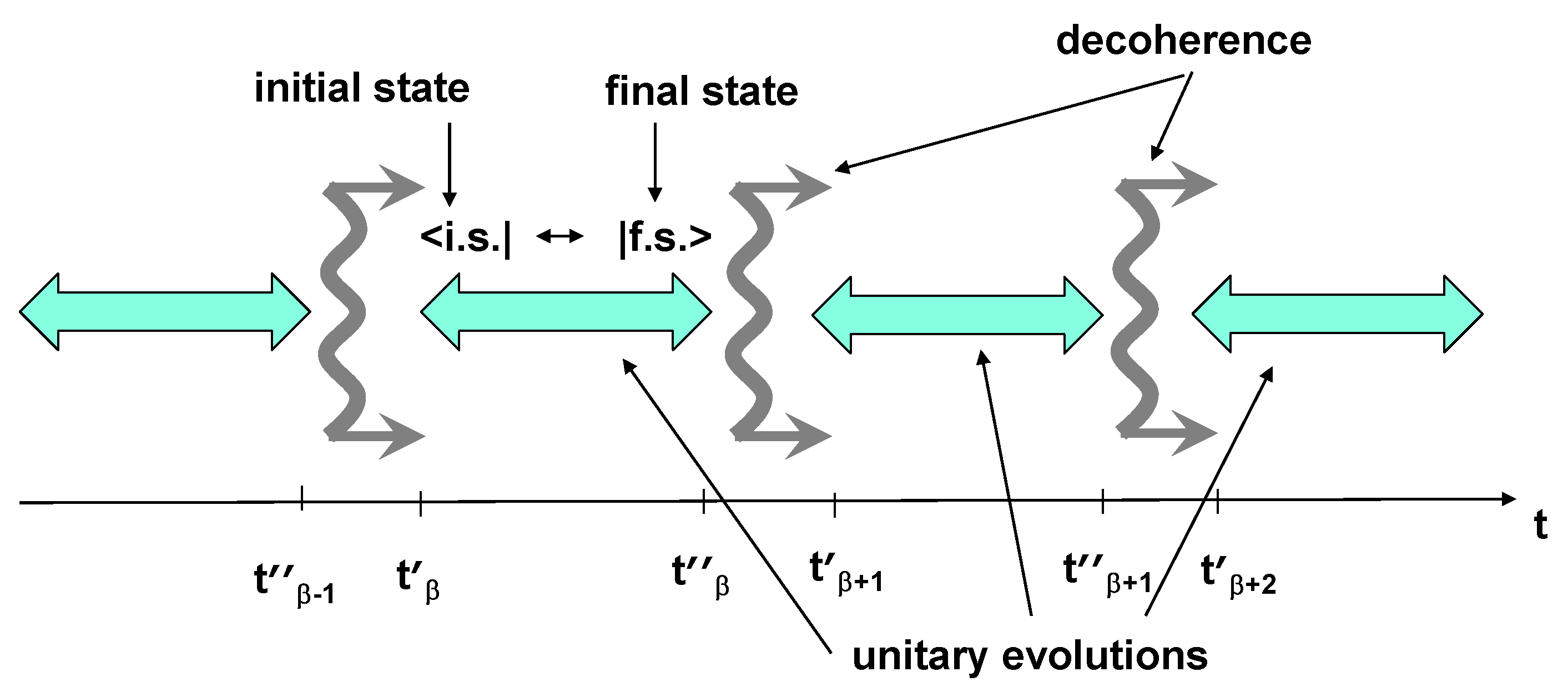

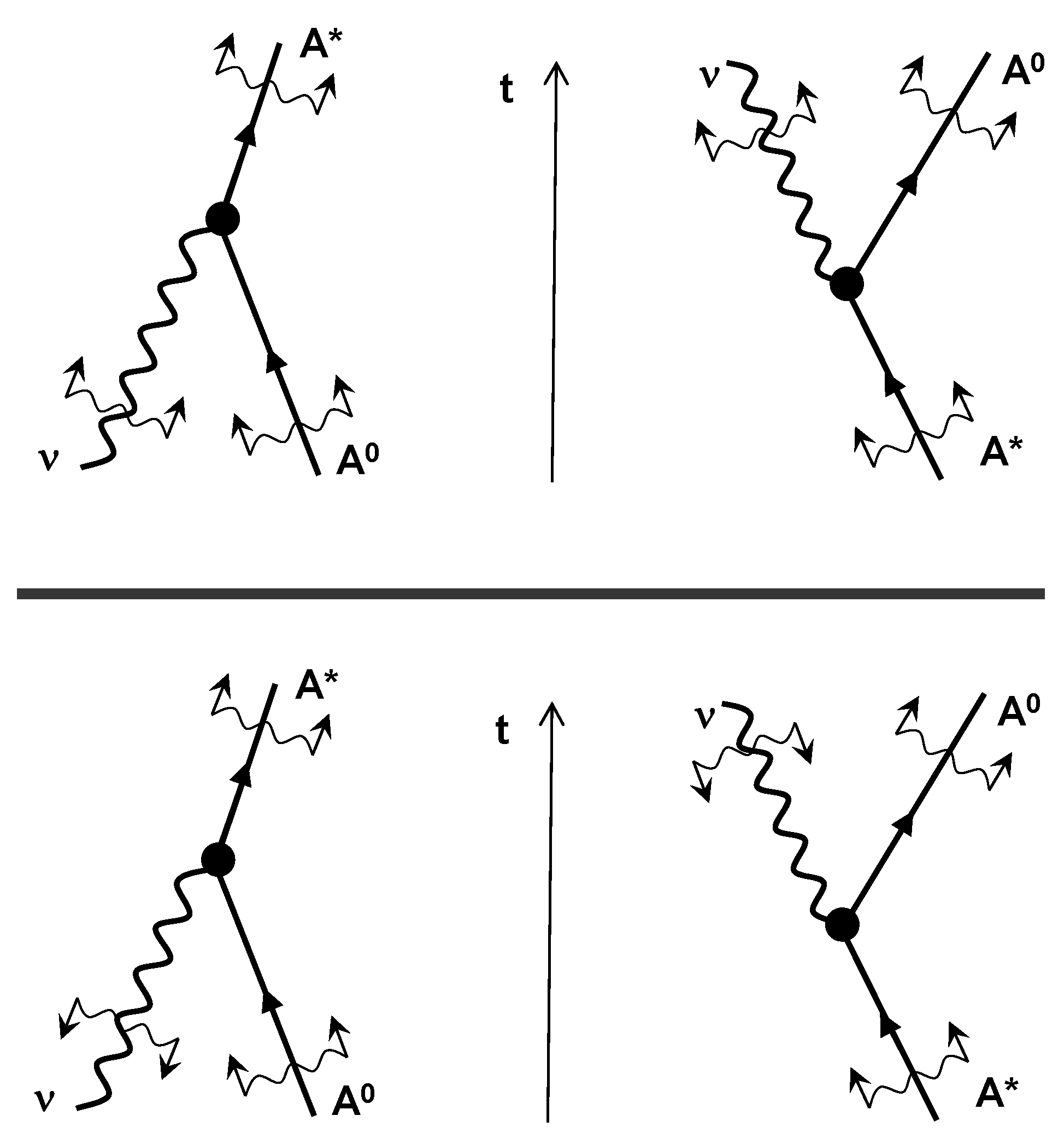
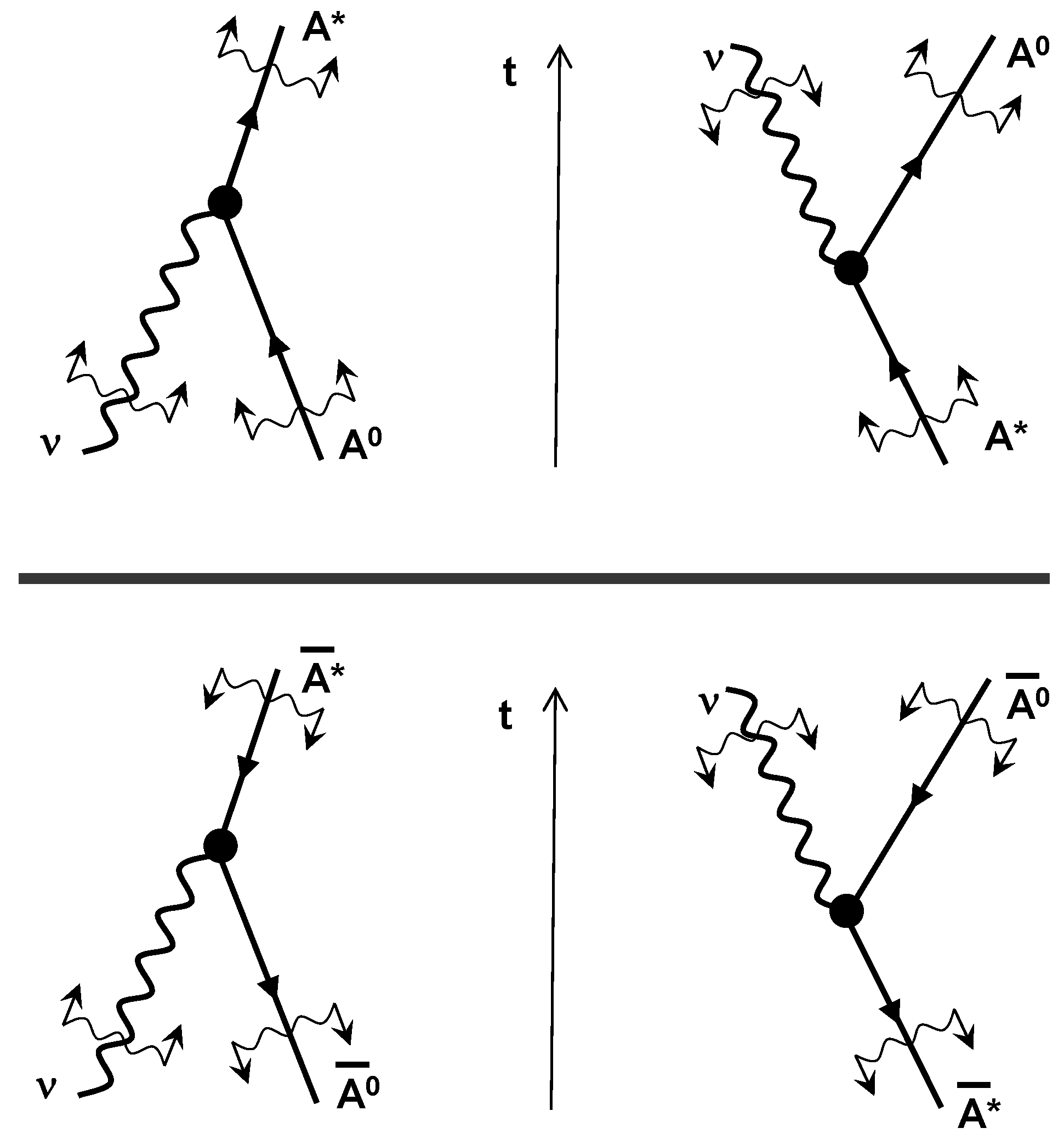
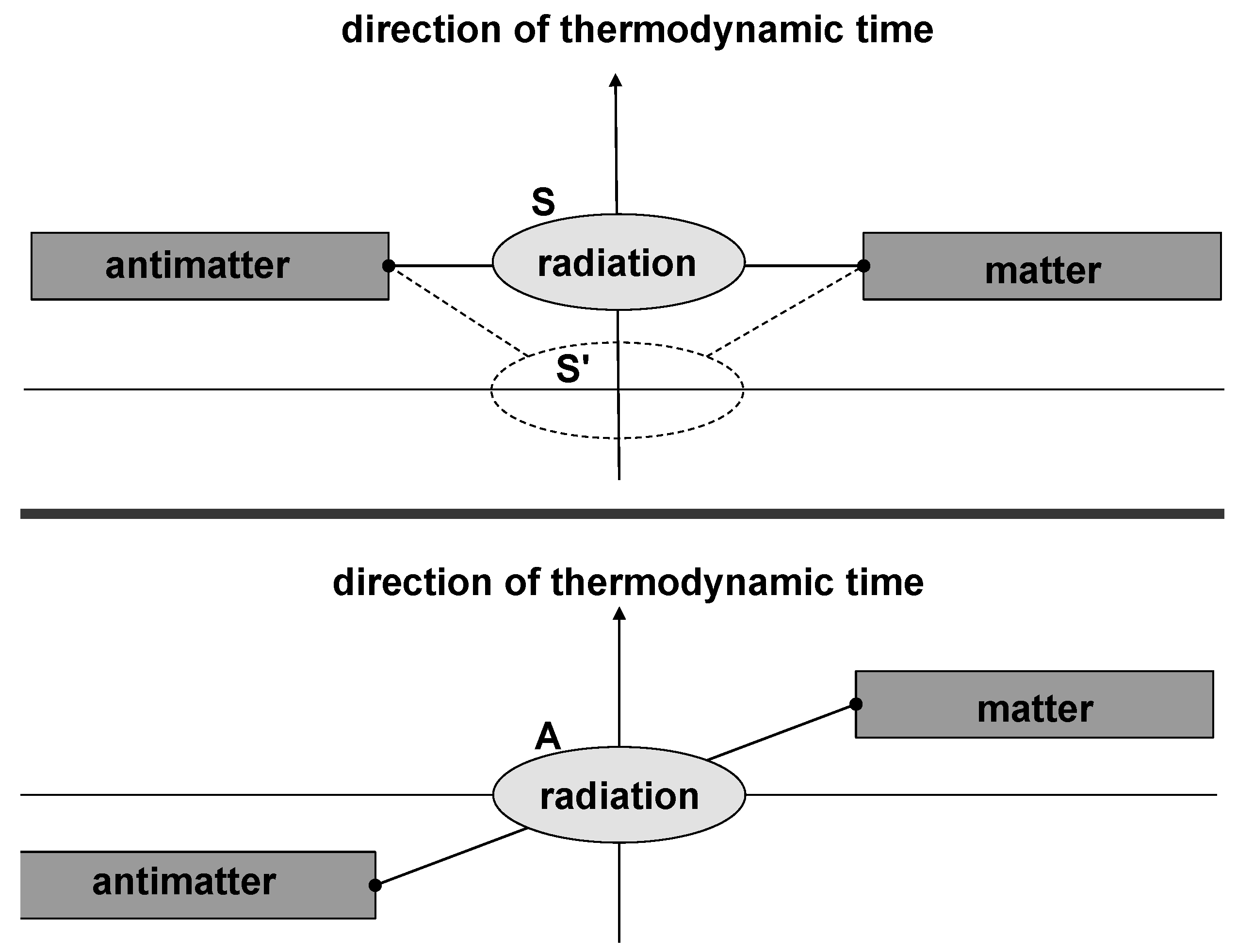
© 2017 by the author. Licensee MDPI, Basel, Switzerland. This article is an open access article distributed under the terms and conditions of the Creative Commons Attribution (CC BY) license (http://creativecommons.org/licenses/by/4.0/).
Share and Cite
Klimenko, A.Y. Kinetics of Interactions of Matter, Antimatter and Radiation Consistent with Antisymmetric (CPT-Invariant) Thermodynamics. Entropy 2017, 19, 202. https://doi.org/10.3390/e19050202
Klimenko AY. Kinetics of Interactions of Matter, Antimatter and Radiation Consistent with Antisymmetric (CPT-Invariant) Thermodynamics. Entropy. 2017; 19(5):202. https://doi.org/10.3390/e19050202
Chicago/Turabian StyleKlimenko, A.Y. 2017. "Kinetics of Interactions of Matter, Antimatter and Radiation Consistent with Antisymmetric (CPT-Invariant) Thermodynamics" Entropy 19, no. 5: 202. https://doi.org/10.3390/e19050202
APA StyleKlimenko, A. Y. (2017). Kinetics of Interactions of Matter, Antimatter and Radiation Consistent with Antisymmetric (CPT-Invariant) Thermodynamics. Entropy, 19(5), 202. https://doi.org/10.3390/e19050202




